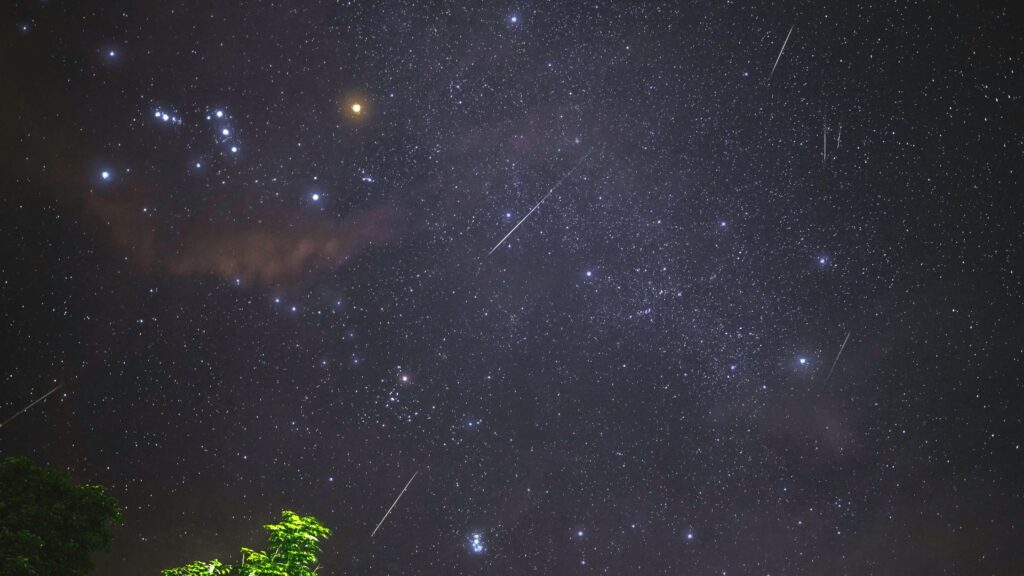The world of astronomy is full of fascination and different intriguing events which can be seen from your rooftop. One such event or phenomenon is a meteor shower, where one can see dozens, if not hundreds, of meteors in the night sky. There are plenty of meteors visible throughout the year, and in April of 2024, the most notable one are Lyrids Meteor Shower.
So, if you’re keen on astronomy or astrophotography, here’s what you need to know about the phenomenon.
Essential Information About Lyrids Meteor Shower
The key highlight of a meteor shower is its origin which comprises of direction or radiation. Additionally, a meteor shower has its peak days, where one can view dozens of meteors in an hour. Lastly, there are some tips and tricks which can elevate one’s viewing experience of the event.
- Astronomical Origins
- Activity In The Northern Hemisphere
- Peak And Other Details
- Elevating The viewing Experience.
Astronomical Origins
Meteors originated from comets—basically, they are the remains and debris which enter the earth’s Atmosphere. And upon their entrance, the drag burns the pieces and is lightened up for a few fractions of a second.
In the case of Lyrids, they originate from the comet C/1861 G1 Thatcher, which will return in the year 2283.
Activity In The Northern Hemisphere
The meteor shower will be visible in the northern hemisphere from mid-April to the end. However, the viewer can expect the maximum probability of meteors on the 21st and 22nd of April. Additionally, a few of the meteors will be visible on the other dates, but their number will be comparatively low. Thus, if you’re able to locate the Vega star of the Lyra constellation, your chances will rise significantly.
Peak And Other Details
On the peak days, the viewer can expect up to twenty meteors in an hour. However, it’s a probable number and can fluctuate based on the actual activity. Additionally, the meteors are expected to reach a maximum velocity of 50 Km/H. Due to the high velocity, Lyrids will produce a flashy fireball, which will be visible for a short duration.
Tips For Elevating The Viewing Experience Of Lyrids Meteor Shower
There are plenty of ways to elevate your viewing experience for the Lyrids meteor shower. But the most notable ones are given below:
- Find a dark and elevated surface.
- Make sure to see it during the new moon.
- Adjust your eyes to the dark
- Track the Lyra constellation’s brightest star, Vega
- Be patient and enjoy.
Conclusion
The Lyrids Meteor Shower, originating from the comet C/1861 G1 Thatcher, is a significant event in April 2024. The shower is visible in the northern hemisphere from mid-April to the end, with maximum visibility on the 21st and 22nd of April. Peak days can see up to twenty meteors in an hour, reaching a maximum velocity of 50 Km/H. Elevating the viewing experience involves finding a dark, elevated surface, observing during the new moon, and being patient.
Frequently Ask Questions (FAQs)
Where to see Lyrids meteor shower 2024?
The Lyrids meteors will be visible in the direction of Vega star of the northern hemisphere. Moreover, to track the Vega star, navigate toward the constellation Lyra.
Can we see the Lyrid meteor shower in India?
Yes, the Lyrids will be visible in India primarily from midnight to early dawn of April 21-22
What is the best time to see the meteor shower?
Midnight (12 AM) to dawn (5 AM) is the best time to see a meteor shower.
Is a meteor visible in India?
Many different meteor showers in the Northern Hemisphere are visible in India. You need prior knowledge about their peak and direction. Thus, you can easily see them with your naked eye.
If you are fascinated by astronomy, check out the articles on astronomy.

